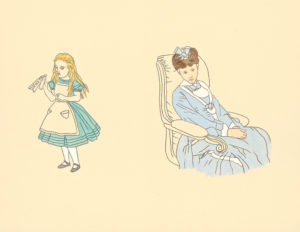Alice Shaw: Photographs, Drawings, and Cheatings
This piece was published as a “Critic’s Choice” column in the San Francisco Bay Guardian. It can be cited here as: Buckner, Clark. “Alice Shaw: Photographs, Drawings, and Cheatings,” www.clarkbuckner.com. Web. Day, Month, Year the post was accessed.

ALICE SHAW Drink Me. Carbon Tracing and Watercolor. 10” x 7.5” 2004
Alice Shaw’s Photographs, Drawings, and Cheatings, presented three approaches to the self-portrait that explored the roles of identification and mistaken identity in constituting the sense of self. One series, constructed with drawing, water-color, and collage techniques, made the most of a productive confusion that Shaw perennially suffers between the outsider-artist, Henry Darger, and the author of Alice in Wonderland, Charles Dodgson, better known by his pen name, Lewis Carroll. Along with confusing Darger and Dodgson, who were both fascinated by the sexuality of young girls, Shaw identifies with the fictional Alice, for whom she was named, and Alice Liddell on whom the character is based. To construct these pictures, she has drawn from John Tenniel’s illustrations for Alice in Wonderland, characters from Darger’s scrolls, Dodgson’s photographs of girls, and pictures of herself. The result is a series of images that both articulate these confusions and present the artist, through her associations, exploring the boundaries of her own identity.
A second series included snapshots of Shaw with people she thinks she resembles in one way or another. In some, the resemblance was clear. She stood beside a slightly hunched, older man, squinting and smiling in matching “Slugs” jerseys, or posed decorated in rouge, mascara and lipstick with the woman behind the Lancôme counter at Macy’s. But what made the series most compelling were the pictures in which the resemblance was not clear at all. Seeing Shaw posing with a grocery clerk at Cala Foods, several non-descript middle-aged women, or a large Latino man with a goatee, the question arose: what leads her to identify with these people? Sometimes they had similar glasses, or similar collars on their shirts, but the repeated appearance of Shaw in each of these pictures produced an effect reminiscent of Woody Allen’s Zelig, which spoke to a desire to identify more than any merely objective correspondence. The photographs expressed affection as much as identification, and gave voice to the importance of belonging in sustaining a sense of one’s self.
For the final series of pictures included in this show, Shaw photographed herself dressed as famous Alices: Alice in Wonderland, Alice B. Toklas, Alice Nelson, and Alice Cooper. But these pictures added little to her otherwise compelling study on account of the superficial objectivity of the connection between the artist and her subject: as merely bearing the same name.
